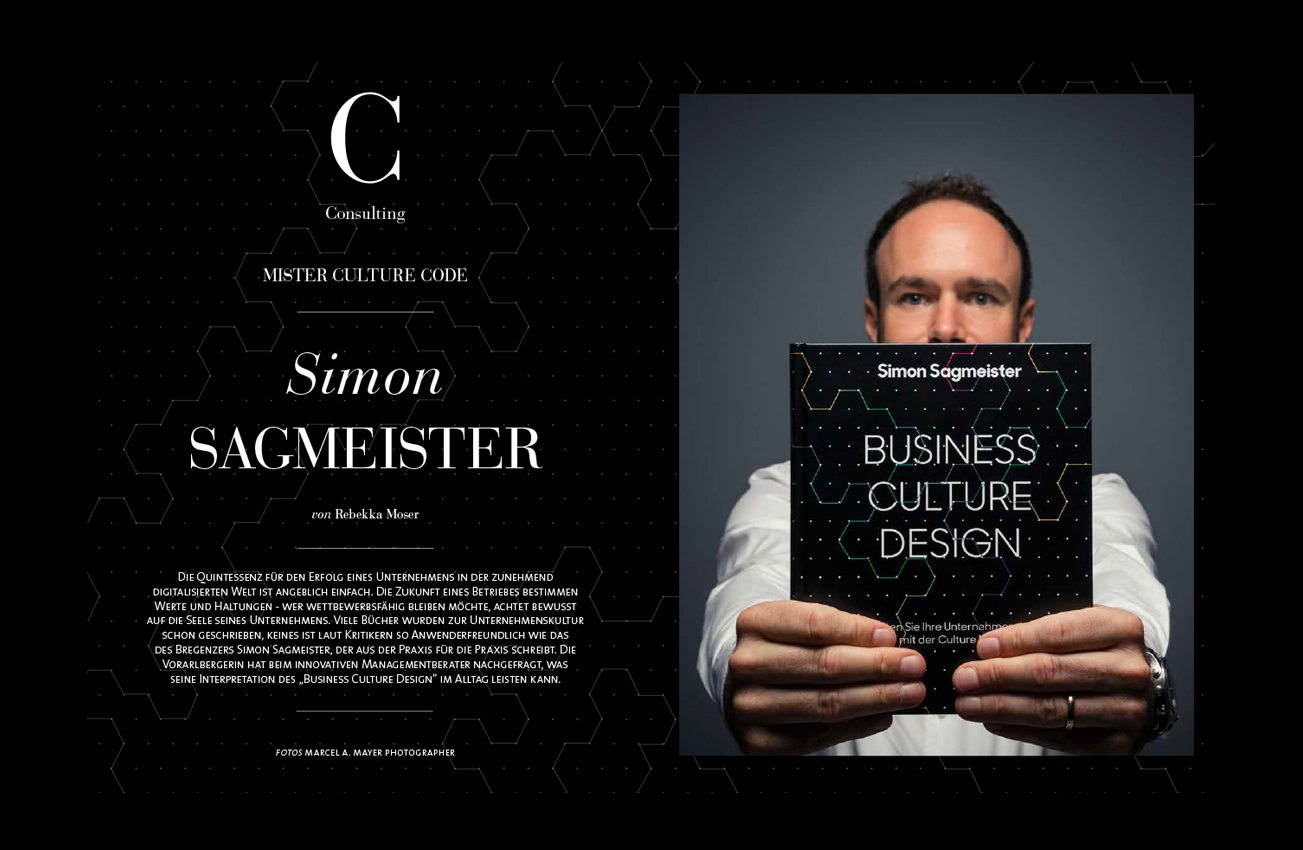
Mister Culture Code – Interview with Simon Sagmeister
by Rebekka Moser
The quintessence for the success of a company in an increasingly digitalized world is supposedly simple. Values and attitudes determine the future of an organization — those who want to remain competitive consciously pay attention to the soul of their company. Many books have been written on corporate culture, but the critics have found none of them to be as user-friendly as the one by Simon Sagmeister, a practitioner writing for other practitioners. Our correspondent asked the innovative management consultant what his interpretation of Business Culture Design can bring to everyday work.
Mr. Sagmeister, why should my boss read your book?
I’m sure that your boss, too, is far from indifferent to how his company or his department runs. The good news is that culture isn’t an accident! The book shows up ways to actively design the mindsets of organizations. What’s more, your boss will find the book to be full of examples and anecdotes from a huge variety of businesses. But the book is meant to be entertaining, too. I can even imagine it pass as vacation literature.
One of your book’s highlights is the Culture Map. Could you explain this term?
The problem with corporate culture is: In discussions, culture often remains unclear, vague, nebulous. The Culture Map helps us visualize cultural patterns. We make culture concrete, something that can be discussed and consciously designed.
This year, your book is going to be published in the US, Japan, and China. Aren’t corporate cultures different there?
There’s no such thing as a single, correct corporate culture anyhow, no matter on which continent. Developing culture must go hand in hand with specific strategic and entrepreneurial challenges. The Culture Map shows which evolved, inherited cultural patterns are likely to be successful in a specific context, and which ones should better be scrutinized.
No improvement without prior analysis—what’s your practical advice?
It’s always interesting to talk to staff who have only been with the company for a month or two. They’ve not yet fully taken the culture on board and are able to remark on things that are considered normal in the culture. That can help you to critically examine habitual ways of thinking and established ways of doing things.
What counts when looking forward?
Corporate culture has come to occupy a more prominent place than it used to. It’s an issue that has made it all the way to the executive floor. And there are at least two reasons for that. In a VUCA world — Volatile, Uncertain, Complex, and Ambiguous — the classic command and control leadership model has less and less chance of succeeding. Which makes it all the more important to design a culture that makes the right decisions by itself and is quick to learn and thus to grow. Secondly, culture is one of the key criteria when choosing an employer – for many it is far more important than the salary package.
Which leadership type is the most successful?
Leadership is not so much a question of type. But what we can observe is that leadership offering purpose and a sense of humanity is moving center stage. A new generation of high performers expects nothing less — and a good dose of autonomy into the bargain. Individuals or small teams have a greater part to play in modern organizations than they used to. Leadership needs to account for that.
What does digital transformation mean for corporate culture?
We conducted a study in which we compared the cultural patterns of Silicon Valley tech companies with traditional champions, and they reveal striking differences. Venerable firms still have a lot of Taylorism in their DNA, which is particularly apparent when you look at how they deal with errors or absorb new lessons. Or as far as agility is concerned. Or how companies treat their own vision — assuming they even have one.
Is there a corporate transformation that you personally find particularly impressive?
The family business that my parents used to run and that is now run by my brother was founded in 1844 and is now in its sixth generation. Each time a new generation took over — at the latest — was a time to reinvent itself. It has always succeeded in finding a place and, while doing so, remaining true to itself and its values.